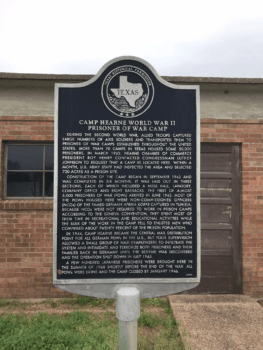Texas A&M Prof Preserving POW Camp Hearne
Many Texans may not know it, but the state was home to more than 50,000 prisoners of war — more than any other state — in about 70 POW sites during World War II, and Camp Hearne was among the largest, housing almost 5,000 POWS in its brief tenure. A Texas A&M University researcher is helping to preserve the memory of the camp and its colorful history.
Mike Waters, professor of anthropology who has conducted research at Camp Hearne over the past 15 years, has helped to archive documents and preserve artifacts related to the camp, located in the city of Hearne, about 20 miles north of the Texas A&M campus. His book Lone Star Stalag details life at the camp and its unique place in Texas history.
Waters says Hearne city leaders petitioned the government to build the camp as a means of boosting the local economy, which it did. The Army bought 720 acres outside of town and construction started in 1942. The camp opened in early 1943 and was equipped to handle 4,800 prisoners.
“Most of the POWS there were non-commissioned officers, and according to the Geneva Convention, non-coms were not required to work,” Waters says of the facility.
“So only a few hundred prisoners did any actual work while the rest spent the day reading, listening to music, woodworking or playing recreational sports. For them, it was almost a country-club type existence, and many of them later said their time at Camp Hearne was one of the best times of their lives. The local citizens often referred to the camp as the ‘Fritz Ritz.’”
The camp may have been one of the most cultured in the U.S. Some of Camp Hearne’s residents were musicians and part of the famed Afrika Korps under the command of legendary German general Erwin Rommel, known as the “Desert Fox.” Not considered military threats, the musicians were allowed to keep their instruments when captured and frequently gave concerts at Camp Hearne, playing for fellow camp inmates or anyone who would listen.
In fact, quite a few of the camp’s prisoners were part of Rommel’s elite Afrika Korps captured in Tunisia. Rommel himself was later involved in a failed plot to kill Hitler and was allowed to commit suicide.

“Camp Hearne is considered a good representation of a typical POW camp in the U.S.,” Waters notes.
“It was a central post office for all of the other POW camps in the country then, and at one time, there were more than 400,000 POWS scattered all over the U.S. in various camps. The Camp Hearne inmates were taught skills, many learned how to speak English and they were healthy and well-fed, and when they returned home when the war was over, they were in much better shape than most people in Germany.”
Waters says that in early 1943, there was a struggle for power between the Nazi and anti-Nazi elements at the camp that culminated with a murder in December of that year.
“After that, the Nazi element was in charge, and while this created a tense atmosphere, most of the prisoners tried to steer clear of trouble and spent their day reading or engaging in other activities,” he says. “By 1945, the camp had a very nice library of several thousand books.”
The number of prisoners at the camp — reaching between 4,800 and 5,000 before it was closed — far outnumbered the population of the town at the time, which was about 3,500, Waters says.
When Germany surrendered in 1945, the prisoners were gradually shipped out and the camp was dismantled, with many of its buildings sold to local businesses for warehouses, offices and even a home for a local pastor.
Waters says it is important to keep Camp Hearne’s memory alive, especially “for students today, so they can see what a real POW camp was like. Camp Hearne now has museum built on the site and it gets quite a few visitors every year. We are trying to do preservation work, and there is a walking tour of the site which is quite interesting.
“I think anyone who likes Texas or World War II history would enjoy a visit to Camp Hearne.”
For more information, go to http://camphearne.com/.
Media contact: Keith Randall, Texas A&M News & Information Services.





